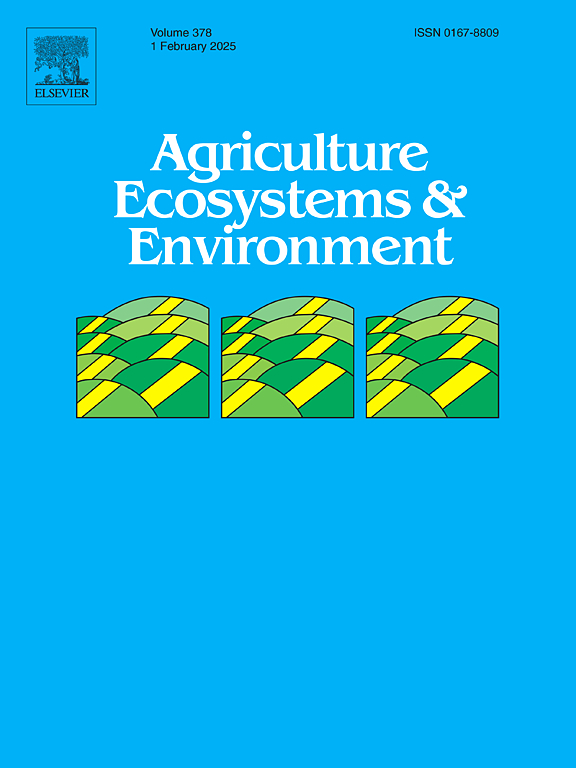Plant community‐dominating species can sustain population biomass by modifying and strengthening their own growth traits to deal with long‐term grazing
IF 6
1区 农林科学
Q1 AGRICULTURE, MULTIDISCIPLINARY
引用次数: 0
Abstract
Unreasonable grazing activities cause grassland degradation, and the most visible sign of degradation is a decrease in productivity. The dominant species not only carry the majority of the community’s biomass, but they also use specific adaptive strategies to deal with grazing pressure. However, more research focuses on a single influence at the community level, ignoring dominant species’ trait responses to multiple environmental variables, as well as trait-based mechanisms of biomass formation. We based it on a grazing experimental platform on an alpine typical steppe. Through situ sampling with a time span of 20 years, we defined various distances from the pasture entrance as the various grazing intensity and chose the dominant species of Agropyron cristatum (A. cristatum) and Stipa purpurea (S. purpurea) to assess how long-term specific grazing management methods shape plant traits and balance their impact on biomass. The findings revealed that long-term moderate grazing increased the population density of A. cristatum and S. purpurea, whereas high-intensity grazing reduced A. cristatum biomass and flattened it while keeping S. purpurea biomass stable and more huge. Grazing in both seasonal pastures widens their crowns on a temporal and spatial (pasture) scale. High-intensity grazing encourages investment in A. cristatum height and density, while warm-season light grazing encourages investment in density in S. purpurea. Cold-season grazing has no effect on S. purpurea. The main factors influencing A. cristatum and S. purpurea traits are climate and soil nutrient availability. In cold-season pastures, A. cristatum and S. purpurea growth traits are strongly correlated with climate, whereas warm-season grazing weakens this correlation. Population density and climate both significantly increase biomass; warm-season grazing promotes A. cristatum density; and S. purpurea density is unaffected by any variables. Soil available nutrients and growth traits have a positive effect on the biomass of A. cristatum and S. purpurea. These findings imply that differences in growth and reproductive traits between plant populations play an important role in biomass maintenance and that different plants may adapt to grazing disturbances by improving specific traits. It is recommended to implement seasonal fence grazing based on the traits of plant community dominant species, matching animal feeding habits and plant growth phenology, in order to promote degraded grasslands restoration and grassland productivity sustainability.
植物群落优势种可以通过改变和加强自身的生长性状来维持种群生物量,以应对长期放牧
不合理的放牧活动导致草地退化,最明显的退化迹象是生产力下降。优势物种不仅承载了群落的大部分生物量,而且它们还使用特定的适应策略来应对放牧压力。然而,更多的研究集中在群落水平上的单一影响,忽视了优势物种对多种环境变量的性状响应,以及基于性状的生物量形成机制。我们基于一个高山典型草原放牧实验平台。通过20年时间跨度的原位采样,以距离牧场入口的不同距离作为不同的放牧强度,选择优势种冠草(Agropyron cristatum, a . cristatum)和紫花针茅(Stipa purpurea, S. purpurea),评估长期特定放牧管理方式对植物性状的影响及其对生物量的平衡影响。结果表明:长期适度放牧增加了凤冠蒿和紫荆蒿的种群密度,而高强度放牧使凤冠蒿的生物量减少并趋于平缓,而紫荆蒿的生物量保持稳定且较大。两种季节性牧场的放牧在时间和空间尺度上都使其冠层变宽。高强度放牧有利于凤冠草高度和密度的投资,而暖季轻度放牧有利于凤冠草密度的投资。冷季放牧对紫花葡萄没有影响。影响凤梨和紫荆性状的主要因素是气候和土壤养分有效性。在冷季放牧条件下,冠草和紫荆草的生长性状与气候有较强的相关性,而暖季放牧使这种相关性减弱。人口密度和气候均显著增加了生物量;暖季放牧提高了冠棘的密度;紫葡萄球菌密度不受任何变量的影响。土壤速效养分和生长性状对鸡冠花和紫荆的生物量有正向影响。这些发现表明,植物种群间生长和生殖性状的差异在生物量维持中起着重要作用,不同植物可能通过改善特定性状来适应放牧干扰。建议根据植物群落优势种特征,配合动物摄食习性和植物生长物候,实行季节性围栏放牧,以促进退化草地的恢复和草地生产力的可持续性。
本文章由计算机程序翻译,如有差异,请以英文原文为准。
求助全文
约1分钟内获得全文
求助全文
来源期刊

Agriculture, Ecosystems & Environment
环境科学-环境科学
CiteScore
11.70
自引率
9.10%
发文量
392
审稿时长
26 days
期刊介绍:
Agriculture, Ecosystems and Environment publishes scientific articles dealing with the interface between agroecosystems and the natural environment, specifically how agriculture influences the environment and how changes in that environment impact agroecosystems. Preference is given to papers from experimental and observational research at the field, system or landscape level, from studies that enhance our understanding of processes using data-based biophysical modelling, and papers that bridge scientific disciplines and integrate knowledge. All papers should be placed in an international or wide comparative context.
 求助内容:
求助内容: 应助结果提醒方式:
应助结果提醒方式:


